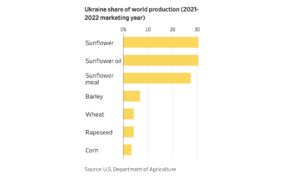The USDA is projecting that the ag trade deficit will shrink in FY2026 even more than previously anticipated. USDA expects the trade deficit to fall from $43.7 billion in FY2025…
Scholz, Macron Urge Russia to Unblock Ukraine Grain- Turkey and Russia to Talk on June 8th, While Land Export Efforts Increase
Financial Times writers Polina Ivanova, Leila Abboud and Max Seddon reported late last week that, “European leaders have stepped up diplomatic efforts to loosen Russia’s hold on Ukraine’s grain supplies as Kyiv’s prospects in the eastern Donbas region worsen and the risk of a global food crisis mounts.
“German chancellor Olaf Scholz and French president Emmanuel Macron discussed the situation with Vladimir Putin in a phone call on Saturday. Putin told them Moscow was willing to find ways to unblock grain exports from Ukraine’s Black Sea ports and could increase its own fertiliser and agriculture exports if relevant sanctions are lifted.
“Their conversation came two days after Italian prime minister Mario Draghi broached the issue with the Russian president in a bid to ease the global food crisis that threatens to inflict hardship in emerging market economies.”
The FT article noted that, “Putin, Scholz and Macron discussed whether a negotiated solution could be found to open Odesa to allow grain exports to leave Ukraine, according to an Elysée briefing after the call.”
Meanwhile, Reuters writer Tuvan Gumrukcu reported today that, “Russian Foreign Minister Sergei Lavrov will come to Turkey with a military delegation on June 8 to discuss creating a potential sea corridor for Ukrainian agricultural exports, Turkish Foreign Minister Mevlut Cavusoglu said on Tuesday.
“In a phone call with Turkey’s Tayyip Erdogan on Monday, President Vladimir Putin said that Russia was ready to facilitate the unhindered export of grain from Ukrainian ports in coordination with Turkey.”
And yesterday, FT writer Andy Bounds reported that, “European leaders will intensify efforts to get food out of Ukraine by land as a Russian blockade of the country’s ports threatens tens of millions of people across the world with starvation.
An EU summit finishing on Tuesday will pledge to improve attempts to find alternative routes to bring out millions of tonnes of grain over the next three months and free Ukraine’s warehouses for the coming harvest, according to draft conclusions seen by the Financial Times.
“A total of 467 wagons can be handled per day at the eight railway border crossings with Poland, Hungary, Romania and Slovakia,” the FT article said.
More narrowly on this issue, Alistair MacDonald, Will Horner and Patrick Thomas reported in today’s Wall Street Journal that, “Across Ukraine, farmers are navigating mines, traversing bombed bridges and risking dangerous maneuvers at overworked ports to circumvent a Russian blockade and get their grains to a world desperate for them.
“But for all their efforts, Ukraine’s strained infrastructure has little hope of being able to handle the 30 million metric tons of corn, wheat and sunflower oil that is expected after harvesting starts in June, farmers and government officials said.
“Less than half of that harvest is likely to be exported, they added, depriving the world of over 8% of all cereal exports and threatening to further stoke food prices and exacerbate shortages.”

Today’s article explained that, “For Ukraine, the immediate race is to fix its railways, roads and bridges faster than Russia can destroy them. Russia is deliberately targeting Ukraine’s infrastructure, said U.S. officials, who have accused Moscow of weaponizing food.”
The Journal article added that, “Kyiv estimates that 8,900 miles of roads and 300 bridges have been destroyed.
“Ukrainian officials hope that big American grain traders, including Bunge Ltd. and ADM, will become key players in its effort to export more grain by investing in expanding capacity at the country’s borders.
“But the U.S. traders worry any investment could be a waste of money if ports reopen.”
In other news, Reuters writer Pavel Polityuk reported yesterday that, “Ukraine’s agriculture ministry said on Monday it would issue its first grain harvest forecast for 2022 in the first days of June.
“The country has almost completed the 2022 spring grain sowing but the acreage is 22% lower than the 2021 level, the ministry said last week.”
Babak Dehghanpisheh reported in Saturday’s Washington Post that, “Street protests in several Iranian cities in recent weeks, sparked by the soaring costs of food and other staples, have underscored the challenges facing Iran’s government from global shortages caused by war in Ukraine and the continued imposition of Western sanctions as talks to restore a 2015 nuclear deal remain stalled.”
Elsewhere, Bloomberg writer Pratik Parija reported earlier this week that, “The monsoon arrived earlier than normal in India, raising hopes that output of crops like rice and oilseeds will get a boost after a brutal heat wave hit winter-sown wheat and prompted the nation to restrict exports.”
Bloomberg’s Sybilla Gross reported yesterday that, “Australian farmers are poised for a potential ‘hat trick’ when it comes to pulling off another bumper crop this season, with winter plantings set to reach a record, according to a Rabobank Group report.
“The planted area is forecast to reach an all-time high of 23.8 million hectares, with growers especially optimistic about prospects for canola — where seeding is up more than 20% on last year. Wheat sowing is expected to climb 1.4%”
Also yesterday, Bloomberg News reported that, “At a time when food shortages and soaring prices are becoming a major concern for governments around the world, China is going all out to make sure that its summer wheat harvest proceeds without any hitches.”





